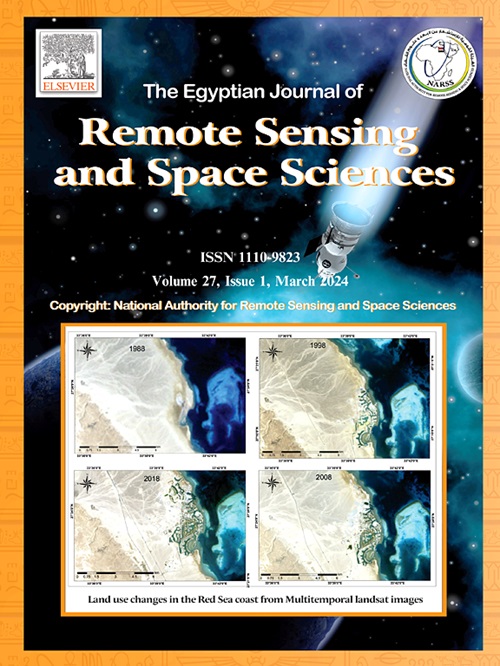动态世界是全球土地覆盖竞赛的竞争者吗?来自基耶州Kastamonu的快速现场评估
IF 3.7
3区 地球科学
Q2 ENVIRONMENTAL SCIENCES
Egyptian Journal of Remote Sensing and Space Sciences
Pub Date : 2025-04-16
DOI:10.1016/j.ejrs.2025.04.002
引用次数: 0
摘要
土地覆盖的变化显著影响全球气候波动。为实现土地资源的合理和可持续利用,必须对开源遥感能力、成果进行识别,并对其地理精度进行评估。本研究以土耳其西北部的Kastamonu省为例,重点比较了三种高分辨率(10米)土地覆盖产品;利用环境系统研究所(ESRI) 2022、欧洲空间局(ESA) World- cover 2021和谷歌-世界资源研究所、Dynamic Word (DW) 2022和2022谷歌地球图像进行空间比较。计算总体精度(OA)和Kappa系数,以及附加的精度评估指标。土地覆盖图的OAs(局部精度)从高到低依次为ESRI2022;76%,至2021年;75.8%和DW2022;73.4%。ESA2021的Kappa系数为0.703(非常好),ESRI2022和DW2022的Kappa系数分别为0.69和0.68(非常好)。在ESA2021中,农作物的最大用户精度值为92.23%,建成区类别的最高用户精度值为92.21%。并对相应的类定义进行了比较。在水、树木和农作物类别中观察到最典型的写照。因此,ESRI、ESA和DW数据集相互之间具有相当的可比性,可以作为水、林业和耕地资源研究的辅助数据。本文章由计算机程序翻译,如有差异,请以英文原文为准。
Is dynamic world a contender in global land-cover making race? A swift field assessment from Kastamonu, Türkiye
Alterations in land-cover significantly influence global climate fluctuations. To utilize land resources rationally and sustainably, it is essential to identify the open-source remote sensing capabilities, the resulting products, and assess their geographical accuracies. This study conceptualized over Kastamonu province in northwestern Türkiye, focused on comparing three of the high-resolution (10 m) land-cover products; Environmental Systems Research Institute (ESRI) 2022, European Space Agency (ESA) World-Cover 2021 and Google-The World Resources Institute, Dynamic Word (DW) 2022, and 2022 Google Earth imagery were utilized for spatial comparisons. The overall accuracy (OA) and Kappa coefficient were computed, along with additional accuracy assessment metrics. OAs of land-cover maps (local accuracy), from highest to lowest, were ESRI2022; 76 %, ESA2021; 75.8 % and DW2022; 73.4 %. The Kappa coefficients for the three land-cover maps were calculated as 0.703 (very good) for ESA2021 and 0.69 and 0.68 (very good) for ESRI2022 and DW2022, respectively. The maximum user accuracy value was recorded at 92.23 % for the crops and 92.21 % for the built area classes in ESA2021. A comparison was also conducted among the corresponding class definitions. The most exemplary portrayal was observed in the categories of water, trees, and crops. Consequently, ESRI, ESA, and DW datasets were found to be fairly comparable to one another and can serve as auxiliary data in research pertaining to water, forestry and cultivated land resources.
求助全文
通过发布文献求助,成功后即可免费获取论文全文。
去求助
来源期刊
CiteScore
8.10
自引率
0.00%
发文量
85
审稿时长
48 weeks
期刊介绍:
The Egyptian Journal of Remote Sensing and Space Sciences (EJRS) encompasses a comprehensive range of topics within Remote Sensing, Geographic Information Systems (GIS), planetary geology, and space technology development, including theories, applications, and modeling. EJRS aims to disseminate high-quality, peer-reviewed research focusing on the advancement of remote sensing and GIS technologies and their practical applications for effective planning, sustainable development, and environmental resource conservation. The journal particularly welcomes innovative papers with broad scientific appeal.

 求助内容:
求助内容: 应助结果提醒方式:
应助结果提醒方式:


